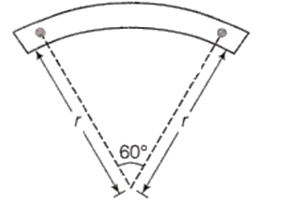 Multiple Choice Questions
Multiple Choice QuestionsA current loop in a magnetic field
experiences a torque whether the field is uniform or non- uniform in all orientations
can be in equilibrium in one orientations
can be equilibrium in two orientations, both the equilibrium states are unstable
can be in equilibrium in two orientations, one stable while the other is unstable
D.
can be in equilibrium in two orientations, one stable while the other is unstable
For parallel M is stable and for antiparallel is unstable
A bar magnet of length l and magnetic dipole moment M is bent in the form of an arc as shown in figure. The new magnetic dipole moment will be

M
A galvanometer having internal resistance 10 Ω requires 0.01 A for a full scale deflection. To convert this galvanometer to a voltmeter of full-scale deflection at 120 V, we need to connect a resistance of
11990 Ω in series
11990 Ω in parallel
12010 Ω in series
12010 Ω in parallel
An electron in a circular orbit ofradius 0.05 nm performs 1016 revolutions per second. The magnetic moment due to this rotation of electron is (in Am2)
2.16 × 10-23
3.21 × 10-22
3.21 × 10-24
1.26 × 10-23
A very small circular loop of radius a is initially (at t = 0) coplanar and concentric with a much larger fixed circular loop of radius b. A constant current I flows in the larger loop. The smaller loop is rotated with a constant angular speed ω about the common diameter. The emf induced in the smaller loop as a function of time t is
A proton of mass m and charge q is moving in a plane with kinetic energy E. If there exists a uniform magnetic field B, perpendicular to the plane of the motion, the proton will move in a circular path of radius
A long conducting wire carrying a current I is bent at 120° (see figure). The magnetic field B at a point P on the right bisector of bending angle at a distance d from the bend is (µ0 is the permeability of free space)

A stream of electrons and protons are directed towards a narrow slit in a screen (see figure). The intervening region has a uniform electric field E (vertically downwards) and a uniform magnetic field B (out of the plane of the figure) as shown. Then

electrons and protons with speed will pass through the slit
protons with speed will pass through the slit, electron of the same speed will not
neither electrons nor protons will go through the slit irrespective of their speed
electrons will always be deflected upwards irrespective of their speed
Two particles, A and B, having equal charges, after being accelerated through the same potential difference enter into a region of uniform magnetic field and the particles describe circular paths of radii R1 and R2, respectively. The ratio of the masses of A and B is
R1 / R2
(R1 / R2)2
(R2 / R1)2
A straight conductor 0.1 m long moves in a uniform magnetic field 0.1 T. The velocity of the conductor is 15 m/s and is directed perpendicular to the field. The emf induced between the two ends of the conductor is
0.10 V
0.15 V
1.50 V
15.00 V
